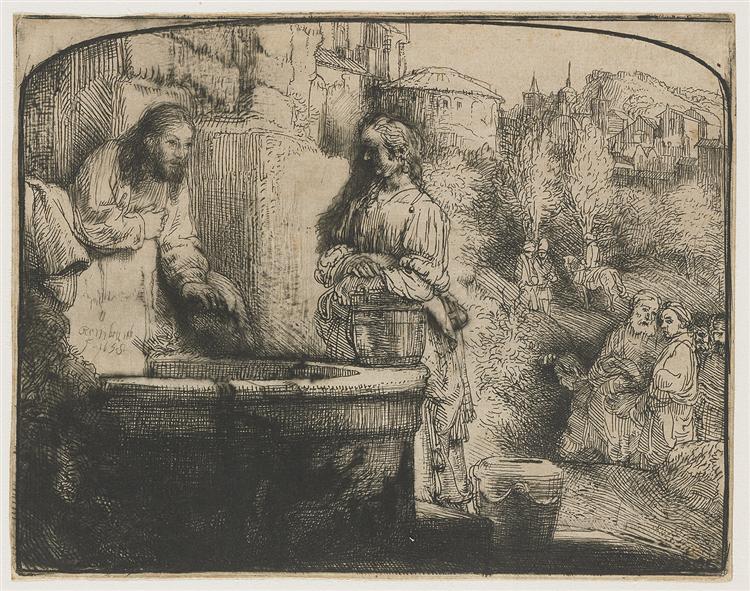Beschrijving
Rembrandt's Christ and the Woman of Samaria, created in 1658, is an outstanding example of the Dutch painter's mastery in depicting moments of intense emotional and spiritual charge. This painting, in the format of an arched print, not only reflects the artist's technical skill, but also highlights his profound understanding of light and shadow, a distinctive feature of his work and of Baroque art in general.
The scene depicts a well-known passage from the New Testament, in which Jesus meets a Samaritan woman at a well, in a dialogue full of symbolism and meaning. This encounter is particularly important, as it represents Jesus' openness to those considered "other" in his historical context. Rembrandt captures this moment with palpable intimacy, using the composition to focus attention on the interaction between the two main characters.
The use of light is fundamental in this work. The soft, warm lighting that shines on the figures of Christ and the woman creates a halo of divinity around Christ, suggesting his nature as the Messiah, while also conferring on the woman an aura of tenderness and vulnerability. This subtle play of light and shadow, known as chiaroscuro, is one of the painter’s most acclaimed techniques, which not only adds depth and volume to the figures, but also establishes a visual dialogue with the viewer about the message and emotion of the encounter.
In terms of colour, the work features a rich but restrained palette, where warm tones of brown and ochre predominate, interspersed with subtle shades of blue that accentuate the woman’s clothing. This colour choice not only highlights the sense of realism in the depiction, but also helps to emphasise the cultural differences and social classes involved in the biblical story. The woman’s attire, with her distinctive turban and colourful dress, reflects her Samaritan identity, while also raising questions about the social and religious divisions that the work was meant to challenge.
Through his distinctive style, Rembrandt moves away from the idealization that often characterizes religious art of his day. Instead, he presents the characters with a palpable humanity, often expressing a mix of emotions that resonate through time. The woman's face is particularly notable in this regard; her expression reflects a mix of surprise, curiosity, and shock at the spiritual revelation being given to her. The interaction between the two characters, in which Christ appears to lean toward the woman, suggests a deep connection that transcends racial and cultural differences.
This work is a testament not only to Rembrandt's talent, but also to his ability to address complex themes such as redemption and equality through painting. In the broader context of Baroque art, "Christ and the Woman of Samaria" aligns with other works by Rembrandt that explore the themes of faith and one's relationship with the divine. His ability to encapsulate moments of spiritual revelation remains a central point of study and admiration in the art world.
This encounter between Christ and the Samaritan woman not only evokes a message of hope and personal transformation, but also challenges viewers to consider the meaning of human encounter and the inherent dignity of every individual, regardless of their background. Thus, this painting stands as a masterpiece not only in its technical and artistic quality, but also in its profound emotional and spiritual resonance, a legacy that continues to speak to this day.
KUADROS ©, a famous painting on your wall.
Hand-made oil painting reproductions, with the quality of professional artists and the distinctive seal of KUADROS ©.
Painting reproduction service with satisfaction guarantee. If you are not completely satisfied with the replica of your painting, we will refund 100% of your money.

